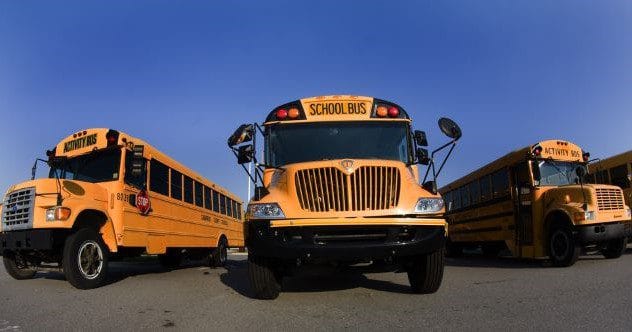School buses are a familiar sight, symbols of daily routines and childhood journeys. We trust them to carry our most precious cargo, and for good reason. The National Transportation Safety Board (NTSB) often calls them the safest way for kids to get to school. But this high level of safety wasn’t achieved overnight. It’s built on lessons learned from heartbreaking events. Behind many modern safety features are stories of tragedies that spurred change. Let’s look at 10 such incidents that, while devastating, led to major advancements in school bus safety.
10. Safer Railroad Crossings
One of America’s worst transportation accidents unfolded in Utah on a snowy December morning in 1938. A fierce blizzard swept through the Salt Lake Valley. School bus driver Farrold Silcox, with three years of experience, was carrying 39 students. As he approached a railroad crossing on the way to Jordan High School, he stopped and looked both ways. Believing it was clear, he proceeded.
Tragically, a freight train, obscured by the heavy snow, slammed into the bus. The impact dragged the bus nearly half a mile. This horrific accident claimed the lives of 24 students and Silcox. Investigators found that the blizzard severely limited the driver’s ability to see the oncoming train. This disaster led to a critical safety rule: now, drivers of any commercial vehicle carrying passengers must stop at railroad crossings, open the door and window, and listen carefully for an approaching train before proceeding.
9. Stronger Bus Manufacturing Standards
School bus design has come a long way since the late 1800s. Each new model aimed to be safer than the last. A tragic event on May 21, 1976, highlighted the need for even stronger buses. Evan Prothero was driving a 1950 Crown bus with 53 passengers. About an hour into the trip, a warning buzzer sounded in the driver’s area, prompting him to exit the highway.
As he tried to leave the highway, he found he couldn’t slow the bus down. The bus struck a guardrail, went over the side, and plunged onto a field below. The impact caused the bus roof to collapse, leading to 28 deaths and many injuries. The NTSB investigation pointed to the bus’s construction as a key factor in the fatalities. This incident spurred new regulations requiring manufacturers to build much sturdier buses, specifically designed to withstand rollovers and similar impacts.
8. Increased Number of Emergency Exits
Sometimes, safety lessons come from incidents where a school bus is used for non-school trips. On the evening of May 14, 1988, a bus carrying children and chaperones home from an amusement park was struck head-on. A pickup truck, driving the wrong way on the highway, caused the collision. The impact ruptured the bus’s fuel tank, and gasoline ignited, engulfing the bus in flames almost instantly.
Passengers rushed to the rear, where the bus’s only emergency exit was located. Tragically, 27 people died. Authorities determined the pickup truck driver was intoxicated and he was later sentenced to prison. The state of Kentucky, followed by national changes, passed laws demanding more emergency exits on school buses. The reasoning was clear: if the bus had been equipped with more ways to escape, many more lives might have been saved.
7. Enhanced Brake System Training
Similar to the previous incident, this accident involved a school bus not on a school-related trip but still transporting children. On July 31, 1991, Richard A. Gonzalez Jr. was driving a 1989 Thomas school bus down a steep mountain road. The bus started gaining speed, and Gonzalez found he couldn’t slow it down. As it sped downhill, he honked his horn to warn the vehicle ahead that something was wrong.
The bus then swerved into the oncoming lane to pass the vehicle. When it reached a bend in the road, Gonzalez couldn’t make the turn. The bus skidded, left the road at high speed, and rolled down an embankment. Seven people died, and 53 were injured. The investigation found the primary cause was the driver’s lack of skill in handling the vehicle on such a steep incline. Consequently, driver training programs were updated to ensure drivers were properly prepared for travel on mountainous roads.
6. Introduction of Child Check Systems
Some accidents happen not because of mechanical failure, but because safety rules aren’t followed. This was the case in a deeply tragic incident on September 11, 2015. Armando Ramirez, a school bus driver in Whittier, California, picked up his three students and dropped them off at school. He then returned the bus to the transportation yard and went home, following his usual routine.
Hours later, a student named Paul Lee was found deceased inside Ramirez’s bus. Ramirez had unfortunately not noticed that Paul never got off the bus. Crucially, upon returning to the yard, Ramirez had failed to follow protocol by thoroughly checking the bus for any remaining children. The student’s death was attributed to the driver’s negligence. This heartbreaking event led to a new California law requiring all school buses to be equipped with a child check system, designed to force drivers to inspect their buses at the end of each route.
5. Training for Hijacking Situations
The Chowchilla kidnapping in 1976 was a terrifying ordeal that, thankfully, did not result in fatalities but did lead to important safety changes. On July 15, Ed Ray, a 55-year-old school bus driver, was on his route after picking up students. He encountered a van blocking the road with a man standing beside it. As Ray slowed to a stop, the man approached, armed, and took control of the bus. He drove it a short distance to where two accomplices waited. Together, they took all 26 children and Ray hostage.
The kidnappers moved their hostages into two modified cargo vans and drove them around for 11 hours. They eventually arrived at a rock quarry in Livermore, California, over 100 miles away. There, they forced the children and driver into a moving van that had been buried in the quarry. Miraculously, Ray and an older student managed to dig their way out of the collapsing, buried van and get help. The kidnappers were caught soon after. Today, many school districts train drivers on how to respond to hijackings. Buses are also increasingly equipped with GPS tracking and video cameras, which are invaluable in such crises.
4. Formation of Dedicated Emergency Response Teams
Sometimes, the aftermath of an accident can be as deadly as the accident itself. This was tragically clear on February 28, 1958, in Prestonsburg, Kentucky. John Alex DeRossett, a 27-year-old bus driver, was transporting students to school. On U.S. Route 23, a tow truck was trying to pull a pickup from a ditch. As the bus passed, it clipped the tow truck, veered sharply left, plunged down an embankment, and into the Big Sandy River.
Twenty-two students managed to escape through the single rear emergency exit as the bus sank. However, the remaining 26 students and the driver were swept downriver and disappeared. The National Guard was called in, but the search and recovery operation lasted for days and drew criticism for its slow pace. This tragic event spurred a significant change: the creation of a dedicated disaster response team for the county. This team was the first of its kind and served as a model for many similar emergency response units across the United States.
3. School Bus Yellow Paint and Two-Way Radios
Early school bus travel faced significant challenges, especially in bad weather. A devastating incident in March 1931 in Colorado illustrates this. Driver Carl Miller began his route on a clear morning. By the time he reached the school, however, the weather had turned into a severe blizzard. Miller and the school’s two teachers decided it was best for the students to return home. On the return journey, Miller took a wrong turn.
The bus eventually slid into a ditch, and the engine died, leaving Miller and his 22 young passengers stranded in the blizzard. Miller left the two oldest children in charge and set out on foot to find help. Two men found the bus later that afternoon and rescued the children. Sadly, the ordeal claimed six lives, including Miller’s. This tragedy led to two crucial safety advancements: the adoption of a uniform, highly visible color for school buses—the “school bus yellow” we know today—and the requirement for two-way radios in all school transportation vehicles for better communication.
2. Onboard Fire Suppression Systems
It’s tempting to think modern school buses are as safe as they can be, but tragic events can still reveal areas for improvement. On December 12, 2017, 16-year-old student Megan Klindt boarded her school bus, driven by 74-year-old Donald Hendricks. As Hendricks attempted to turn the bus around on a narrow street, he backed too far, and the rear of the bus dropped into a ditch. He tried to accelerate to free the bus, but it remained stuck.
Shortly after, the bus was engulfed in flames. Megan’s family saw the fire and immediately called 911. Tragically, both Megan and Hendricks died in the fire. The NTSB investigation concluded that the driver had difficulty safely backing up the bus. The fire’s cause was determined to be the ignition of fuel on the engine’s turbocharger, which had overheated. Following this accident, a key recommendation was made to equip all school buses with fire suppression systems.
1. Operator Responsibility in Inclement Weather
While many school bus accidents involve mechanical issues or driver error, some are the result of unfortunate circumstances. Royal J. Randle, a 24-year-old World War II veteran, was a school bus driver for the Lake Chelan School District. On November 26, 1945, he was on his usual route when it began to snow. Since there was initially little snow on the road, he didn’t put on tire chains.
As the snow fell heavily, it quickly accumulated on the bus’s windshield, causing the wipers to fail. Visibility became extremely poor. Randle decided to pull over to clear the windshield. As he did, the bus hit a rock. This caused it to swerve into a 30-foot embankment, roll over twice, and come to rest with its front end submerged in the lake. Five students and one adult managed to escape before the bus sank further. Divers later recovered seven bodies, including the driver’s. Nine other children remained unaccounted for. The Washington State Patrol concluded that poor visibility led to the crash. They also stated that the school district had a responsibility to halt bus operations during such severe weather. Today, both bus drivers and school districts share the crucial responsibility of deciding when weather conditions are too dangerous for transporting students.
These ten stories are sober reminders of the high stakes involved in student transportation. Each tragedy brought immense sorrow, but from these painful lessons came vital changes. The safety features and protocols on modern school buses—from their bright yellow color and emergency exits to driver training and onboard technology—are often the direct result of learning from past mistakes. While we can never forget the lives lost, we can appreciate how these events have shaped a much safer journey for millions of children every day.
What are your thoughts on school bus safety today? Do you know of other advancements? Leave your comment below!










